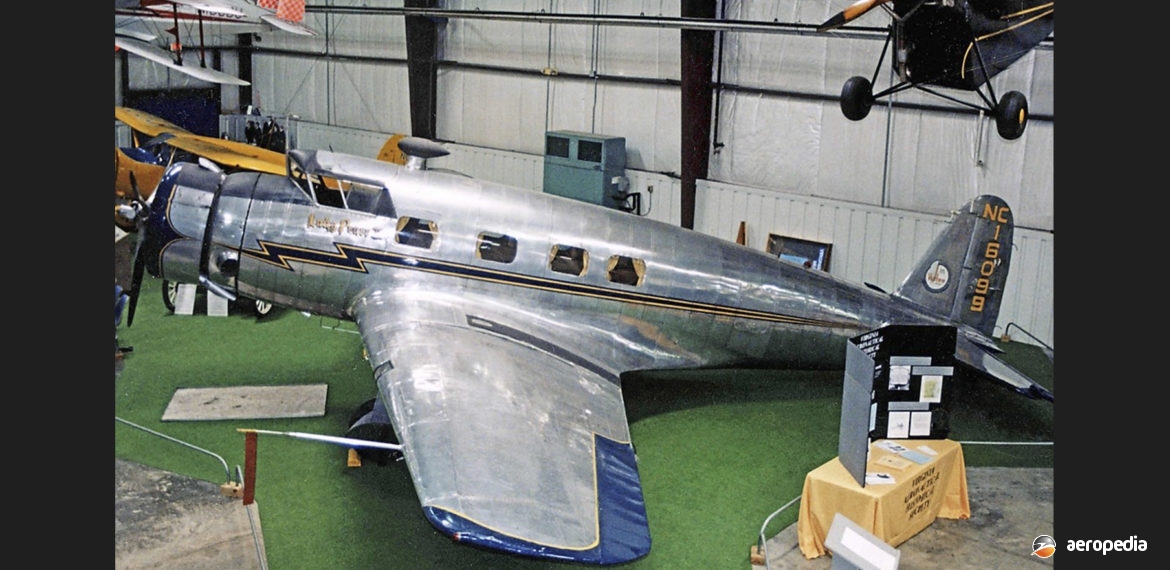Photograph:
Surviving Vultee V.1A Special NC16099 at the Shannon Air Museum in Fredericksburg in Virginia, USA (David C Eyre)
Country of origin:
United States of America
Description:
Commercial airliner / business and executive monoplane
Power Plant:
One 531 kw (712 hp) Wright R-1820-F2 nine-cylinder air-cooled radial engine
Specifications:
- Wingspan: 15.24 m (50 ft)
- Length: 11.28 m (37 ft)
- Height: 3.10 m (10 ft 2 in)
- Wing area: 32.3 m² (348 sq ft)
- Max speed: 346 km/h (235 mph)
- Cruising speed: 378 km/h (215 mph)
- Rate of climb: 305 m/min (1,000 ft/min)
- Service ceiling: 6,100 m (20,000 ft)
- Range: 1,610 km (1,000 miles)
- Empty weight: 2,424 kg (5,332 lb)
- Loaded weight: 3,864 kg (8,500 b)
History:
The prototype V.1 (NR12293) with a 531 kw (712 hp) Wright R-1820-F2 engine was first flown on 19 February 1933. Production totalled 26 aircraft. It was designed by Gerald Vultee and Vance Breese, and was built by Airplane Development Corporation. An initial order was placed for ten, with an option on ten, by American Airlines. The production variant was the V.1A, the first aircraft (NC13764) being delivered on 18 July 1934. However, restrictions were introduced in the United States on the airline’s use of single engine aircraft. A few became corporate aircraft and a number took part in the Spanish Civil War.
There is an Australian connection in relation to the type. Two examples were amongst the 64 entrants in the 1934 MacRobertson Air Race, being allotted race Nos 50 and 64, but in the event neither took part in the race. Race No 50 (NC13770 – c/n 8) was purchased by George Hutchison to operate with New York – London – Moscow Airlines Inc. It was entered in the speed section of the race as NR13770 but the purchaser failed to find funds to purchase the aircraft and ownership was not transferred. Richard Merrill was to be the pilot and the aircraft was named Lady Peace. In September 1936 it was flown from New York across the Atlantic but instead of landing in Ireland made a forced landing in Wales after 18 hrs 38 mins and achieving a speed of 351 km/h (218 mph).
After repair this aircraft attempted a return flight but force landed in Newfoundland. It was taken to New York, rebuilt, and exported to the Republican Government in Spain by ship. However, the ship was seized by Nationalist forces and the machine entered Nationalist service as 43-14, being named Capitan Haya. It seems twelve V.1As reached Spain and a few survived up to 1950. The subject aircraft is recorded as being scrapped in 1953. One example survives on display at the Shannon Air Museum in Fredericksburg in Virginia, USA.
A second V.1A powered by a Wright Cyclone F2 engine was entered in the 1934 race by Australian, H W G Penny, to be flown by Penny and American George R Bond. Allotted race No 64, difficulties were experienced with obtaining finance from sponsors and when it was finally ready to proceed to the UK to commence the race it was grounded in New York due to fog and did not manage to get to the starting line in time.
In December 1935 Australian airline, New England Airways, sought permission from the Comptroller of Civil Aviation to import new airliners for the company’s services, at the time intending to expand its fleet. Amongst these were the Douglas DC-2, Junkers Ju-52/3m, Lockheed 10, Boeing 247D, Curtiss Wright Condor, Stinson Model A and Vultee V.1A. However, due to restrictions on the carriage of passengers in single-engine airliners that were introduced in the US, the company imported three examples of the Stinson Model A and no example of the Vultee V.1.

